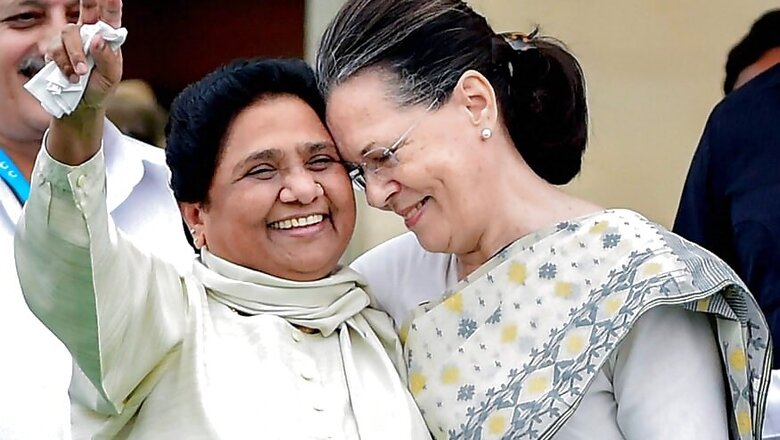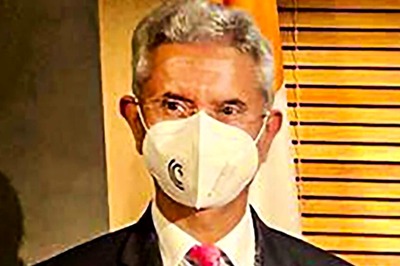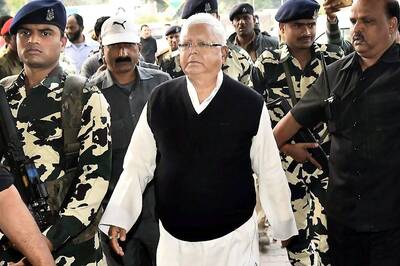
views
New Delhi: At the swearing-in ceremony of Karnataka chief minister HD Kumaraswamy in Bengaluru last month, the bonhomie shared by Mayawati and former Congress chief Sonia Gandhi spoke volumes about the role BSP’s supremo might play in the national political spectrum.
While on its own the party may not garner enough votes to even come close to power, it has pockets of influence in these provinces to tilt the political balance in the upcoming Assembly elections. If the outcome in the recently held by-elections in Uttar Pradesh are anything to go by, the BSP’s dedicated and transferable votes may well be the deciding factor in some of the poll-bound states.
The BSP doesn’t have an alliance with any political party in Madhya Pradesh, Rajasthan and Chhattisgarh. Contesting on its own strength, it has been able to maintain its vote-share in the last three elections. In the last general elections, the BSP with close to 4% votes interestingly was the third largest party is terms of vote share after the BJP (31 percent) and Congress (19.3 percent).
That, perhaps, is the reason why Mayawati has silently become the most sought after political personality in the country in recent times and almost every Opposition party is trying to woo her to forge an alliance.
In votes polled by varies parties in the last three elections—2003, 2008, 2013¬—in Madhya Pradesh, Rajasthan and Chattisgarh were to hold, a BSP-Congress alliance, can keep BJP at bay in these crucial states. That’s why, perhaps, the potential of alliance arithmetic is appealing to both Congress and BSP.
The BSP has a much smaller footprint in terms of vote share and seat share in these states. But what is also noteworthy is that the combined vote share of the Congress and the BSP exceeded that of the BJP in six of these nine elections (2003, 2008, 2013 ).
Madhya Pradesh
For the past 20 years, Mayawati’s BSP has polled an almost steady 7% vote share across the state of Madhya Pradesh. If one adds the Congress vote share in the last elections—37%—then the Congress-BSP alliance may likely give the BJP a run for its money. Things can worsen further for the saffron party as a recent Lokniti-CSDS survey in May registered a higher anti-incumbency in Madhya Pradesh vis-à-vis Rajasthan. According to the same survey, the Congress is performing rather well in Madhya Pradesh where it is ahead of the BJP.
Another reason for a Congress-BSP tie up in Madhya Pradesh is that historically the BSP has been known to cut the vote share of the Congress, thus indirectly benefitting the BJP. Take for example the 2013 elections. The BJP won 165 seats, the Congress won 58 and the BSP managed to get 4 seats. While the BJP was a clear winner, the BSP managed to ensure the defeat of the Congress candidates in more than 30 seats, where there was a close contest. The Congress lost 19 seats in Madhya Pradesh by a margin of less than 3000 votes and 7 more seats by a margin of 5000 votes. Most of these losses were partly because BSP managed to cut the Congress party’s vote share.
That could be reason why, according to many media reports, the BSP is planning to contest elections in 55-60 of the 230 seats in the Assembly polls in Madhya Pradesh in comparison to the 2013 polls when the party contested elections in 227 seats, forfeiting deposits in 194 seats.
A constituency wise analysis of 2013 polls also showed close contests where the BJP won only because the Congress and the BSP cut each other’s votes, giving a crucial advantage to the BJP. Constituencies like Sheopur, Vijaypur, Jawad, Jaura, Sumaoli, Morena, Dimani, Ambha (SC), Bhind, Lahar, Mehgao and Ashok Nagar (SC) are examples were the Congress and the BSP together could have thrown the BJP out of the picture had they joined hands.
A look at last the three elections show that the combined vote share of the Congress and the BSP is either more that the BJP or very close to it.
In the 2008 assembly elections, the BJP had got nearly 38.09% of the vote share, while the Congress had got 32.85% and the BSP 9.08%.
In the 2003 elections, the BJP had got nearly 37.64% of the vote share, while the Congress had got 32.39% and the BSP 8.97%.
The BSP currently has four seats in the Madhya Pradesh Assembly, from the Chambal and Rewa division.
What is worth noting is that in the five bypolls held so far in Madhya Pradesh the Congress has managed to win four seats. Interestingly, on all these seats the BSP did not field any candidates.
Rajasthan
In the last Assembly elections held in 2013 in Rajasthan, the BSP could manage only 3.44% of the total votes, down from 7.6% in the 2008 polls. The party could also only manage to win 3 seats in the state, down from 6 seats in 2008.
Dalits votes, which are considered crucial in forming next government in the state, account for more than 15 percent of the total votes. Traditionally, the Dalits have always supported the Congress in Rajasthan but if the Congress and the BSP join hands in the state, it can further consolidate their position in taking on the BJP, which is already facing a strong anti-incumbency.
Unlike other states, Rajasthan is a bipolar state with no third party managing to play a kingmaker. The BSP registered its presence in 1993 when it fielded 50 candidates for Assembly and secured 0.56 percent votes. In 1998 Assembly elections, the BSP managed to win two seats with 2.17 percent vote share. The BSP again won two seats in 2003 Assembly elections and increased its vote share by 3.97 percent, playing an important role in ousting the then ruling Congress.
In 2008 when the first term of BJP’s CM Vasundhara Raje ended, the BSP secured 7.6 percent vote share, which was almost twice to 3.98 in 2003. In 2013 Assembly election, the BSP's vote share dipped to 3.44 percent.
If one analyses the 2003 and 2008 Assembly polls in the state, the combined vote share of the BSP and the Congress is more than that of the BJP. Add to that: Whenever the BSP faces an anti-incumbency wave, its poll prospective improves, both in terms of vote share and seat share.
It worth to note that after the 2008 Assembly polls, 6 BSP MLAs had joined the Congress and helped Ashok Gehlot form government in Rajasthan, as the Congress was three short of majority.
But Rajasthan is one state where state Congress leadership seems not inclined to tie-up with the BSP. An alliance of this nature can disrupt the caste matrix Congress may use to return to power. Also, Rajasthan is one of those states where the Congress still has a statewide presence and is capable of challenging the BJP on all the seats.
Chhattisgarh
When the results were declared for the 2013 Assembly elections in Chhattisgarh, the BJP won 49 seats while the Congress won 39 seats, with 41 percent and 40.3 percent vote share, respectively. The BSP was the distant fourth in terms of seat share when the party only won 1 seat. But if one looks at their vote share, which was 4.3 percent, the party could have dented the BJPs fortunes had it gone with a pre-poll alliance with the Congress. Together their vote share in 2013 Assembly elections added up to 44.6 percent, 3.6 percent ahead that of the BJP’s.
Not only that, the BSP was the worst sufferer in the 2013 Assembly elections, when its vote share declined from 6.12 to 43. percent.
However, after 2013 Assembly elections, the BSP developed a considerable base among Scheduled Tribes that form 32 percent of the state’s total 20.08 million population and Scheduled Castes who are 12 percent. Out of the 90 seats in the state, 29 seats are reserved for ST and 10 for the SC candidates.
A constituency-wise analysis of 2013 polls also showed close contests where the BJP won only because the Congress and the BSP cut each other’s votes, giving a crucial advantage to the BJP. Constituencies like Pamgarh (SC), Bharatpur-sonhat (ST), Takhatpur, Beltara, Janjgir-champa, Sakti, Chandrapur, Dongargaon are examples where the Congress and the BSP together could have kept the BJP at bay had they joined hands in a pre-poll alliance.
Surprisingly in Chhattisgarh, during the Modi wave of 2014, the vote share gap was about 8.6%. It was only 0.7% during the election of 2013. After 15 years of Raman Singh, a Congress-BSP alliance can pose a tough challenge to the BJP.
However, with former CM Ajit Jogi leaving the Congress to launch his own party, the electoral calculations may vary this time around with Jogi seeking to make dent into Satnami belt in central Chhattisgarh.
Jogi has recently had a meeting with BSP chief Mayawati in Delhi triggering speculations on BSP-Jogi tie-up in the state.

















Comments
0 comment